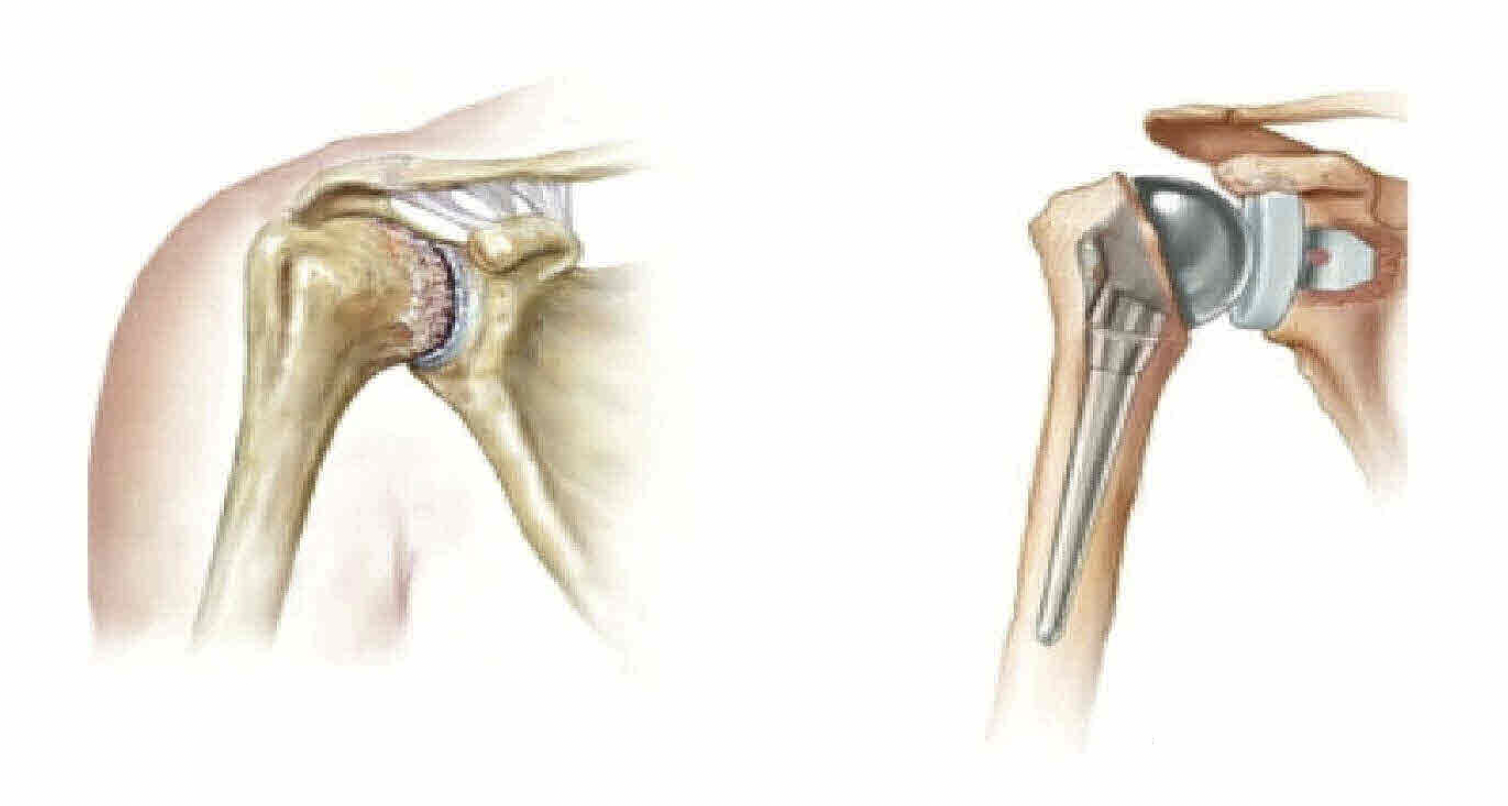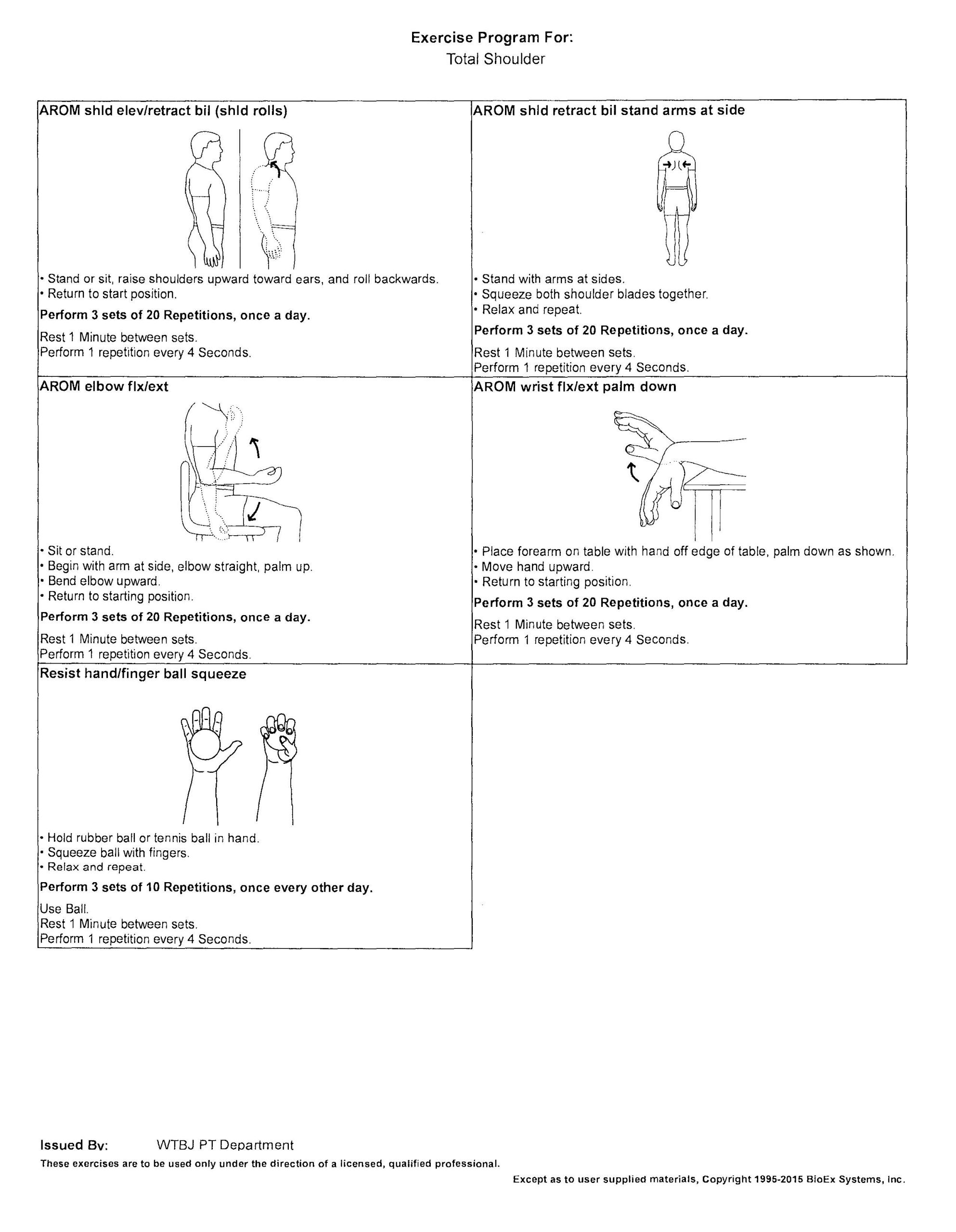What’s wrong with my shoulder?
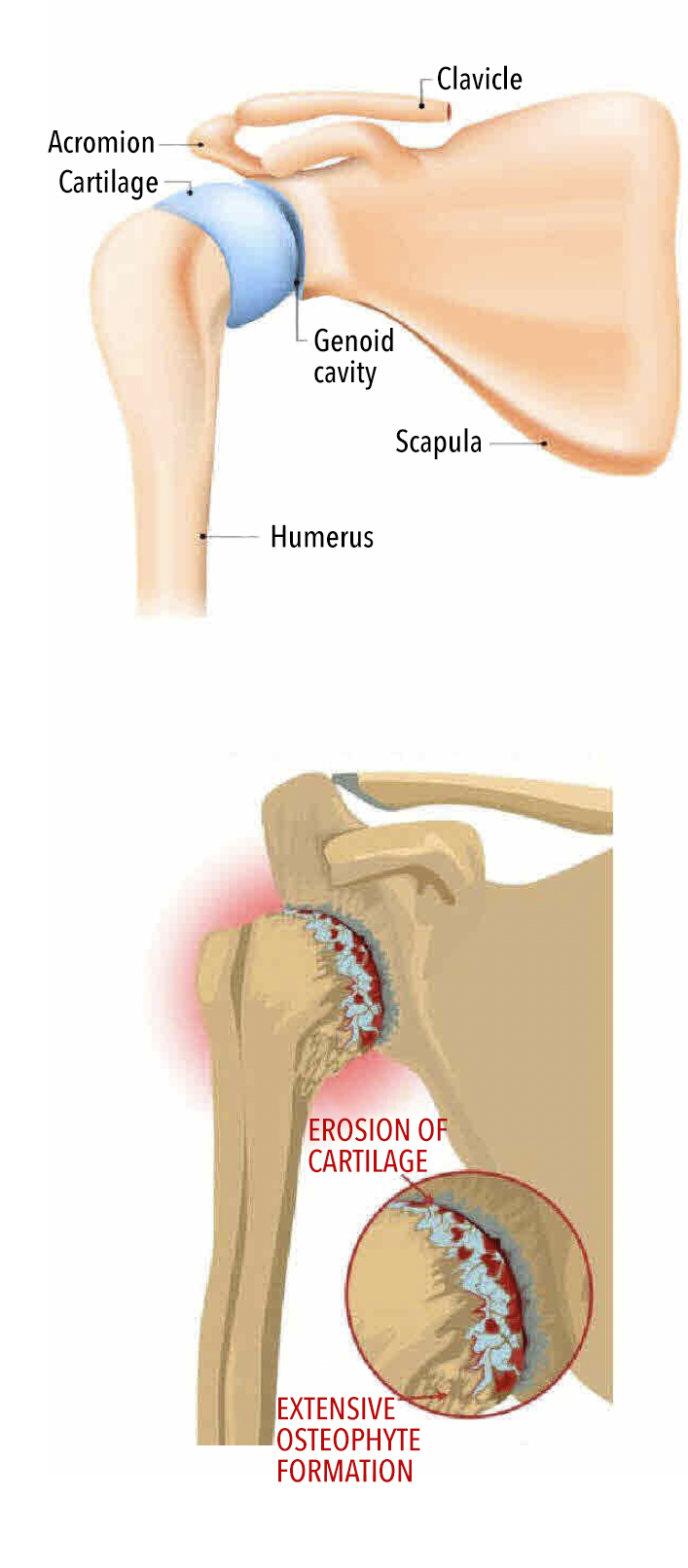
Joint replacement surgery, also known as arthroplasty, is done when a patient experiences severe, incapacitating pain due to osteoarthritis, rheumatoid arthritis, injury, or avascular necrosis. The old joint is replaced with a new mechanical joint called a prosthesis. The parts of the prosthesis consist of metal and plastic implants.
A healthy shoulder consists of a smooth ball called the head of the humerus (upper arm bone) and the scapula (shoulder blade). The head of the humerus moves against the scapula in a socket called the glenoid. This forms the “ball and socket” joint. A layer of lubricating tissue called cartilage cushions the ends of these bones allowing the ball to glide easily within the socket.
A problem shoulder can be the result of wear and tear to the cushion of the cartilage in the shoulder joint due to osteoarthritis or other diseases. The wearing of this cartilage causes bone to rub against bone causing irritation, swelling, stiffness, and discomfort.
 A shoulder prosthesis consists of a specially designed ball and socket that replace your worn shoulder joint.
A shoulder prosthesis consists of a specially designed ball and socket that replace your worn shoulder joint.
Reverse Total Shoulder Replacement
The patient that is suffering from osteoarthritis pain as a result of a rotator cuff tear would be a candidate for “reverse total shoulder replacement,” which reverses the anatomy of the shoulder so that the deltoid muscle controls raising the arm. The ball is attached to the scapula ( shoulder blade) and the socket is placed on top of the humerus.
Standard Total Shoulder Replacement
The patient that is suffering from pain as a result of osteoarthritis or degenerative joint disease, without rotator cuff tearing, is a candidate for standard replacement. This involves replacing the arthritic humeral head (ball) with a metal ball and replacing the glenoid (socket) with polyethylene (plastic). During this replacement,. one of the rotator cuff muscles has to be cut to expose the joint but it is repaired at the end of surgery.
Shoulder Hemiarthroplasty
Hemiarthroplasty is a partial shoulder replacement. It replaces the damaged head of the humerus with a metal ball and stem. The glenoid is left intact. This would be recommended for the following conditions: severe humeral head fracture but normal socket, humeral head severe arthritis but normal socket.
Before surgery you may be asked to attend and/or obtain the following:
- Medical Clearance
- Cardiac Clearance
- Other Clearance
- Dental Clearance
- Pre-op Physical Therapy Evaluation & Home Exercise Program Instructions
- Total Joint Class
- Pre-Admit Appointment
Medical and dental clearance
Knowing your overall health helps give you better and proper medical care while in surgery and during your hospital stay. Therefore, you may be requested to provide pertinent information about yourself from your medical doctor to better assist in that care. This may include EKG’s, blood work, cardiac stress test, pulmonary function test, etc.
Because the threat of infection is a major risk factor to joint replacement, we may also request dental information regarding the status of your teeth and gums. A silent or unknown infection in your mouth could travel through your bloodstream and cause infection around your prosthesis, which could be devastating to your new joint. This would require additional operations, hospital stay and lengthy use of antibiotics. If you have not seen a dentist in the last twelve months, we may request that you make an appointment for a dental exam prior to surgery.
Pre-admission testing appointment
Pre-admit within 30 days of your surgery date
(Please call for an appointment)
Jackson Madison County General Hospital
620 Skyline Drive, Jackson, TN 38301
731-541-6919
West Tennessee Healthcare North
367 Hospital Blvd., Jackson, TN 38305
731-661-2211
Physicians Surgery Center
207 Stonebridge Blvd., Jackson, TN 38305
731-661-6340
- An outpatient registration (OP) specialist will register you. He or she will record your insurance information. After this, a nurse will see you.
- The nurse will complete a Nursing History & Anesthesia Assessment. Please have your medicines or an up-to-date list that includes the strength of your medicines ready for the nurse. We also need to know about any over-the-counter medicines, vitamins, or herbal supplements that you take. If you do not know your medicines today, it is very important that you bring them with you on the day of your surgery or procedure. If possible, please bring your medicines in their original bottles. Some medicines can affect your surgery or anesthesia. For this reason, it is important that we know everything that you have taken within the last week.
- We will complete any lab work, chest x-rays or EKG’s ordered by your doctor. This will help to make the process smoother on the day of your surgery or procedure. Please tell your nurse if you have had an EKG or chest x-ray done at any other facility in the last six months. If possible, bring a copy with you. In some cases, we need to repeat some of your labs, your EKG or chest x-ray.
- In some cases, your PCP or Cardiologist may obtain labs, x-rays and EKGs prior to your pre-admit appointment. These should be faxed to WTBJI at 731-668-6757 and to JMCGH at 731-541-9777.
- The nurse will give you information and instructions about your surgery or procedure. You will also be given the name and phone number of the nurse who works with you today. Please feel free to call us with any questions that we can help you with before your surgery.
- Your doctor’s office will schedule your surgery. They will let you know what time to arrive at the hospital the day of surgery. Please call them with any other questions or any concerns.
- We are open Monday through Friday. We see many patients every day and there may be a wait as we help others. We apologize for any inconvenience and thank you for your patience.

Frequently Asked Questions
1. What about my daily medications before surgery?
At the time of your pre-admission testing, the medications you routinely take will be reviewed with you. You will be advised to stop taking any medications before surgery, such as anti-inflammatory pills. You will also be told which medications to take the morning of surgery with a small sip of water. You will be given specific instructions about how soon before surgery you should stop taking blood thinning medications.
2. How long will I be at the surgery facility?
For joint replacement surgery, the majority of patients are able to go home the day of surgery.
3. What if I need extended care?
Your goal is to go home, as quickly and as safely as possible. However, a few patients are not yet capable of managing at home. Other arrangements may be made by your surgeon.
4. Will I have the opportunity to ask questions?
Questions and concerns will be addressed at the time of your visit with the surgeon. You will also have opportunities to ask questions during the time of your pre-admission testing. Also, feel free to call 731-661- 9825 for any further questions.
5. What do I do with FMLA, disability or additional insurance forms such as AFLAC etc?
These forms need to be sent to the medical records department because they require specific coding and attachment of medical records. You may call 731-661-9825 for the medical records department with questions or you may fax the form to 731-668-6757 to the attention of the medical records department. It is important that you get those in as soon as you know your surgery date because they can take up to 10 days for completion.
Positive approach to planning your joint replacement
Preparing mentally for surgery is just as important for you and your family or support person, as it is for your surgeon and the rest of the medical team involved in your shoulder replacement procedure. Because of medical advancements, total joint replacement surgery should relieve your pain and discomfort and improve your activity level. It is important to remember that the pain and activity limitations after surgery will be different than what you are experiencing now, and that they will be short term.
Your stay in the hospital will be short and your recovery will be continued after discharge. It is important for you to make a commitment to follow your doctor’s instructions and work on your exercise plan after surgery in order to benefit most from the joint replacement. If you or your family need support coping with surgery and recovery- either physically or emotionally – please talk with the staff. The improved lifestyle after recovery is worth the risk and stress of surgery.
Prepare for your procedure
Start your checklists to prepare for your hospital visit
Your physician’s office may provide you with this manual in advance of your surgery. Please take time to read your manual, ask any questions, and make sure that you take care of the things that need to be done several days or weeks ahead of the surgery date. Surgery is your primary path toward getting yourself back to being the person you want to be—so don’t let any unnecessary delays stand in your way!
Making arrangements
Taking care of a few items now will help make your return home smoother and safer! As we have discussed, total joint replacement surgery can relieve the pain and discomfort of your arthritic joint. However, there is a six-to-eight-week recovery period after your surgery during which you will experience different types of pain and discomfort. During this recovery phase, you will be using your new joint according to the instructions given to you at discharge and by your physical therapist as directed by your physician. We ask you to stay committed to these instructions and to your exercise plan. However, there are some limitations and arrangements that need to be made prior to surgery to ensure an easier recovery afterward.
Transportation
- You will not be driving initially after surgery. Your surgeon will instruct you when it is safe to resume driving. This is typically about 6 weeks.
- You may need to find someone to drive you to therapy and to your doctor’s appointments.
- You may also need someone to pick up groceries, medicines, etc.
Work
Arrange to be off work full duty for 6 months, although you may be able to return sooner. The exact length of time will be determined by your doctor.
Prepare your home for your return
Kitchen
- Move most frequently used items to the counter so you can reach them without bending over or climbing (food, skillet, utensils, dish-washing items).
- Freeze meals or schedule to have a friend bring you meals for 4-6 weeks.
- You may find it helpful to stock up on prepared foods such as canned, boxed or frozen foods.
- Check to see if your local grocery store will deliver orders to you.
Bedroom
- If your bedroom is on the second floor, get creative!
- Find a space on the first floor to call your own for the first couple of weeks.
- Stock this area with things you need for the day, so you can rest.
Bathroom
- Put non-skid material in the bathtub or shower.
- You will need to avoid soaking in a bathtub for the first 2-3 weeks.
“Fall-proof” your home
- Remove all throw rugs.
- Check rooms for small objects, cords or stools that could cause tripping.
- Use a rolling cart to move items around and to keep them within easy reach.
- After surgery, wear your prescribed immobilizer at all times except to shower and for therapy. If you are sitting for a while you may undo it and move your arm at your elbow (like rubbing your stomach) but always keep your upper arm next to your side and do not move it at the shoulder. You can move your hand at the wrist.
- Change positions slowly and avoid rushing to prevent loss of balance.
Other tips
- Rearrange your most frequently used items to a convenient level, about waist height.
- Place a phone within easy reach wherever you are.
- Make sure that you have good lighting and that the light switch is within easy reach.
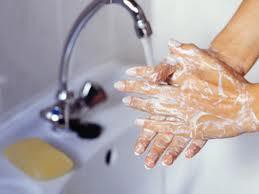
Help prevent infection…
- Taking a bath or shower is recommended the night before or morning of surgery.
- Do not apply lotion to the area where surgery is to be performed.
- In the hospital and at home, performing proper hand hygiene is essential.
- Wash your hands before eating and after using the rest room.
- Wash your hands after petting your animal(s).
- If you develop any skin lesions that are suspicious for infection anywhere on your body you must notify Dr. Smith’s office so that it can be evaluated before surgery. If you develop a urinary tract infection or upper respiratory infection before surgery you should notify us as well. Any infection could travel to the prostheses and, if that happens, all the hardware has to come out.
Your defenses may be down after surgery, which is normal. Any step you can take to prevent infection is a step in the right direction.
The friends' and family's role in your recovery
Your family and friends are very important in helping you during your recovery.
Examples of ways they can help you prepare:
- Stock up on canned and frozen or packaged food.
- Move your most frequently used items (such as food, skillet, extra toilet paper, soap, etc.) to cabinets between your waist and shoulder level, helping you avoid reaching and bending.
- Prepare a room for yourself with all the needed supplies so that you can rest during the day.
- Remove rugs and other clutter for safe walking.
- Run errands, grocery shop and drive you to follow-up doctor’s appointments.
- Arrange for your caregiver to attend at least one of your therapy sessions in the hospital after surgery.
My primary caregiver(s) when I get home from the hospital will be _________
phone # _________
What should I bring to the hospital?
Items to bring the morning of surgery:
- Your driver’s license and insurance/Medicare card.
- A list of all medications you are currently taking. Please include dosage and instructions. Also, include over-the-counter medications and herbal supplements.
- A loose-fitting T-shirt or button up shirt.
- A caregiver who should be with you in the hospital to be part of your care team, when possible.
Pack the following items in a bag and leave in your car just in case you were to have to stay overnight:
- Personal hygiene items (toothbrush, deodorant, lotions etc.)
- Eyeglasses or contact lenses with case
- Knee-length light weight gowns, robes or nightshirts
- Dentures, hearing aids, prostheses
- Any special equipment or other daily activity aids as applicable
- If being treated for sleep apnea, bring C-pap fitted mask, tubing and pressure settings. If you do not know the pressure readings/settings, call the prescriber’s office where you purchased the machine or the sleep study center to obtain the pressure readings/settings.
What should I leave at home?
- Cigarettes and all tobacco products
- Jewelry, remove all body piercings
- Credit cards
- Large sums of money (anything more than $5)
- Keys
- As pleasant as we want your stay with us to be, you won’t need to bring much in the way of luggage!
What else should I know?
- Do not eat, chew gum, or suck on or eat mints, drink or smoke after midnight the night before your surgery unless instructed to do so by your physician. You may brush your teeth and rinse with mouthwash. Your physician highly recommends you stop smoking/use of nicotine four weeks prior to surgery.
- Take any medicines as directed the morning of surgery with a small sip of water.
- If diabetic, check with your primary care physician about how to adjust your diabetes medication.
- Please leave your belongings (like your suitcase and walker) in your car until your room has been assigned.
- Surgery usually lasts one and a half to three hours.
- During your surgery, your family will be free to visit the cafeteria or other designated areas. Someone from surgery will contact them either on their cell phone or a hospital-assigned phone. They typically will call when your surgery begins and every hour after that. Your surgeon will contact them after the surgery is complete.
- Narcotics may cause constipation. You are already prone to constipation because of surgery and lack of exercise. Increasing fiber intake and stool softeners while on narcotics may be a necessity. You need to have at least one bowel movement every 3 days. If on the third day you haven’t had a bowel movement you will need to take a laxative such as Milk of Magnesia or Dulcolax.
- It is important for you to breathe deeply to help your lungs clear and avoid complications, such as pneumonia. Bed rest, drowsiness, anesthesia and pain often keep you from taking normal deep breaths. If you are given an incentive spirometer at the hospital, remember to use it for 10 repetitions every hour. You can cough and breathe deeply in the absence of an incentive spirometer.
Day of discharge: going home after shoulder replacement
Once you are stable enough to be discharged, you will go home. The majority of patients go home the day of surgery. Most patients will travel by car driven by a family member or friend. Please make these transportation arrangements before coming to the hospital for surgery. Insurances will not cover ambulance transportation to your home.
Discharge instructions
Discharge is a busy time. You will be given the following by the orthopedic nurses:
- Instructions on medications to resume at home
- Instructions on how to take care of yourself
- Instructions on when and where your staples or stitches will be removed
- Your first postop appointment at which time your stitches or staples will be removed
- We request that you call your surgeon’s office and verify your follow-up appointment with the physician who performed your surgery. If there is any information that you do not understand, please ask the staff before you leave.
“Call Us First” (1-888-661-9825) if you have:
- Increased redness, bleeding, pain or swelling on or around your incision
- Fever higher than 101 ° or as specified by your doctor
- Change in color or amount of drainage more than seven days after surgery
- Shortness of breath and/or chest pain, seek immediate attention at an emergency room
- Any other questions or concerns
Recovery
The past few weeks you have prepared for surgery, waited to enter the hospital, undergone surgery, and made plans for going home. Once you are stable enough to be discharged from the hospital, you will enter the recovery and rehabilitation phase of your surgery. For the next six to eight weeks, you will continue to heal and recover. You should balance periods of activity with periods of rest. Do not try to overdo or push yourself to the point of pain or exhaustion.
Activity
Follow the activity guidelines and exercises as instructed by your doctor or physical therapist. Always ice your shoulder after any extended activity or exercise.
- Wear the immobilizer AT ALL TIMES, even while sleeping until your follow-up appointment with Dr. Smith. This protects your shoulder. You may remove when showering. However, your arm SHOULD BE HELD CLOSE TO THE SAME POSITION AS IF THE IMMOBILIZER WAS STILL ON.
- You will have a nerve block before surgery. The medication used in this should give you shoulder pain relief for 2-3 days. You may have finger and hand tingling until it wears off; this is normal.
- Sleeping in a recliner may help to take some pressure off your shoulder and may be more comfortable than lying flat in a bed.
- Do ankle pumps continuously throughout the day to reduce the possibility of a blood clot in your calf
- NO DRIVING until instructed otherwise by Dr. Smith.
Sitting
- Do not sit for longer than 30 minutes at a time. Get up, walk and change positions.
- On long car trips, stop at 30-minute intervals. Get out and move around.
- For the first few weeks you will want to rest in a recliner.
Swelling
It is normal for the shoulder to bleed and swell following surgery. If blood soaks the PICO bandage, please let Dr. Smith know. The most common area for swelling is your hand and upper arm. You can do hand pumps by making a fist and then extending your fingers. You can also move your wrist. Cold packs reduce swelling (and pain). Use a cold pack often; up to 30 minutes per hour is acceptable. Cold packs may also be applied after exercise.
Dressing
When putting on your blouse or shirt, always put the surgical arm in first, but keep that arm to your side and just slide the sleeve up. When removing your blouse or shirt, take the nonoperative arm out first and then you can slide the sleeve easily off the operative arm.
Therapy
- Follow rehab instructions as told in the hospital
- NO ACTIVE MOTION OF THE SHOULDER
- PASSIVE motion only until further instruction
- Outpatient physical therapy (PT) will be scheduled at your first post-operative visit.
Ice Therapy
- Begin immediately after surgery. Use ice packs continuously for 20 minutes every 2-3 hours daily until your first post-operative visit. This will help reduce pain and swelling of the shoulder.
- DO NOT place directly on skin
Sports
- DO NOT use exercise equipment, whirlpools or spas until your doctor tells you it is ok.
- DO NOT participate in sports after your surgery until your surgeon tells you it is ok.
- Please talk with your doctor about the type of sports you like to do. You may eventually resume some sports that do not put your shoulder at risk.
Driving
- DO NOT drive until your doctor tells you it is okay.
Wound Care
- You will have an incision in your upper arm.
- Maintain your operative PICO dressing, which is a negative pressure dressing. It draws out excess fluid from a wound and protects the incision. It is ok to shower over the PICO dressing; just place the battery back in a Ziploc bag to avoid getting it wet.
- Keep the dressing dry and in place for 7 days following surgery. At that point, you may remove the dressing and throw it all away, including the battery pack. You will need to replace the dressing with the dressings that were sent home from the hospital with you. You may continue to shower ONLY if the wound is covered with a water resistant dressing available at local pharmacies. (in general, a gauze dressing covered by “Saran Wrap” with tape applied to the edges of the plastic wrap will suffice for brief showers.
- Your wound will be covered with small “strips”. Do no remove these. These will fall off over time.
- Your arm may be bruised down to your elbow and may be swollen. This occurs routinely. If the skin becomes “shiny” or the wound starts to drain, contact Dr. Smith immediately.
- Sutures or staples should be removed at around 14 days by Dr. Smith or his office staff after he has appropriately evaluated the wound. Five days after they are removed, you may shower or bathe unless you are having wound problems.
- You should carefully wash under your axilla (armpit) at least twice a day and keep the area clean and dry. This may require a family member to assist.
- Keep your arm in the sling AT ALL TIMES. except when bathing or in physical therapy.
- DO NOT apply any ointments or lotions to your incision.
Emergencies–Contact Dr. Smith or his nurse at 731-661-9825 for:
- Unable to urinate 6-8 hours after surgery
- Unable to have a bowel movement for 3 days
- Painful swelling or numbness
- Unrelenting pain
- Fever (>101 degrees. It is normal to have a low-grade fever for the first day or two after surgery) or chills
- Redness around incisions
- Continuous drainage or bleeding from incision (a small amount of drainage is expected)
- Difficulty breathing
- Excessive nausea/vomiting
Things to Remember
- You now have an artificial joint.
- Because you now have a joint made of artificial material, any infection needs prompt treatment to avoid spreading into the artificial joint.
- Antibiotics are recommended to be taken prior to any dental or urinary tract procedures. This remains true the rest of your life.
- Please remind all doctors and dentists in the future that you need to have antibiotics because of your joint replacement.
- You now have an artificial joint.
- Even after being released from treatment from Dr. Smith, you will always have weight lifting restrictions on your shoulder.
- Too much stress on the artificial shoulder will cause the shoulder to loosen or wear out sooner.
- You now have an artificial joint.
- You should be seen by Dr. Smith at least once per year for the rest of your life to take x-rays of your shoulder.
The facts about pain management
During and immediately following your surgery, you will receive pain medication by injections or through the IV. As you begin to recover from your surgery, you will be switched to oral pain medication. If you receive a nerve block before surgery, your pain should be much more tolerable for the first 2-3 days.
What will be your goal for pain control?
Some degree of pain is unavoidable. While you are in the hospital, you will be receiving pain medication to help control pain. It is important to tell your nurse if you are having pain. Don’t wait until the pain is severe. The more severe the pain, the harder it is to control. We will try to reduce your pain without compromising your ability to move, breathe deeply, or care for yourself.
Your nurse will ask you to rate your pain. A pain scale helps you rate your pain intensity. In the scale, 0 means no pain, and 10 is the worst pain possible. We cannot relieve all your pain, and you may feel some pain even with medications. However, we should be able to reduce it to a level of five or less. Be sure to mention if the pain suddenly increases or changes.
Important points:
- You will NOT be totally pain free.
- Pain medication is usually taken regularly. Don’t try to be a “hero” and wait too long or skip a scheduled dose in the first day or two after surgery.
- The longer you wait to take pain medicine, the worse your pain will become, taking longer to get under control.
- Contact your doctor’s nurse if your pain medication is not working or if you don’t like the way it makes you feel.
- Unrelieved pain robs your energy and takes away important time you could spend working towards a faster recovery.
- Your surgeon will prescribe pain medication to keep you comfortable. With strict federal laws regarding opioid use, it is important that you only take these medications as prescribed.
Some other things you can do to try to control your pain
- Watching TV
- Changing positions
- Reading a book
- Listening to relaxation tapes
- Find out what works best for you
Exercise Program for Total Shoulder
Shoulder Arthroplasty Rehabilitation Program
PODl to 6 weeks – AA/PROM only
- Sling on at all times except during therapy or bathing
- Forward elevation – in the plane of the scapula as tolerated, up to 90°
- Internal rotation, with upper arm at side, to chest
- External rotation, with upper arm at side, 0-20 degrees
- AA➔AROM for elbow, wrist, and hand
6-12 weeks – continue AA/PROM
- Sling is removed unless otherwise specified by MD
- Forward elevation to full
- External rotation to 30 °
- Wand and overhead pulley
- Isometric strengthening for flexion, extension, external rotation, and abduction in neutral position only
At 12 weeks – start AROM/strengthening
- Continue AROM, stretches, and Theraband strengthening
- Progress strengthening
- Progress to home program
Preventing post-op infection
You have undergone a total joint replacement procedure. There are instances when infection in one part of the body may cause bacteria to circulate in your blood, possibly resulting in infection at the site of your implant. Therefore, it is essential you seek prompt treatment of infections anywhere in your body.
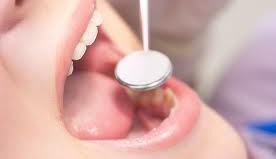
Good dental hygiene is important. You should see your dentist for regular dental care whether you are having a dental problem or not. Prompt treatment of any kind is important, including dental procedures such as the following:
- Dental extraction
- Periodontal procedures including surgery, sub-gingival placement of fibers/strips, scaling and root planning, probing, recall maintenance
- Dental implant placement and re-implantation of avulsed teeth
- Root canal instrumentation or surety only beyond apex initial placement of the orthodontic bands but not brackets
- Intraligamentary local anesthetic injections
- Prophylactic cleaning of teeth or implants where bleeding is anticipated.
Recommendations for antibiotic therapy from the American Association of Orthopaedic Surgeons are the following:
- Patients not allergic to Penicillin: Cephalex, Cephradine, or Amoxicillin 2 grams orally one hour prior to any dental or invasive procedure
- Patients not allergic to Penicillin and unable to take oral medications: Cefazolin 1 gram or Ampicillin 2 grams IM/IV one hour prior to any dental or invasive procedure
- Patients allergic to Penicillin: Clindamycin 600 mg orally one hour prior to any dental or other invasive procedure
- Patients allergic to Penicillin and unable to take oral medications: Clindamycin 600 mg IM/IV one hour prior to any dental or other invasive procedure.
No second dose is recommended for any of these dosing regimens.
The avoidance of bacterial contamination and infection should help reduce the risk of infection at the site of the total joint implant. Since prompt treatment is essential, please do not hesitate to consult your personal physician, your dentist or your surgeon should such a situation arise.
Concerns about addiction
You are taking narcotics because you hurt. When your pain from surgery decreases, your need for the pain medicine will decrease. The fears you or your family may have about addiction could:
- Prevent you from taking pain medicine
- Result in your “holding off” as much as possible between doses
- Result in taking lower doses of pain medicine when you still hurt.
All of these result in needless suffering. Talk to the staff if you have concerns or fears about pain medication, a history of drug abuse, sensitivity to pain medication or low tolerance to pain.
Facts about addiction
- Addiction rarely happens in patients taking pain medicine to relieve postoperative pain (fewer, than 1% of patients).
- Most people are able to reduce or stop pain medicine when the pain decreases or disappears.
Taking pain medicine at home
- You will be given a prescription for pain medication.
- Plan ahead if you are getting low on pain medication. You may find it difficult to refill your prescriptions for pain medications during weekends, evenings or holidays.
- Within a few weeks, most patients can take Aleve® or Tylenol® for occasional pain. If, you’re still having a lot of pain at that time, it is important to discuss this with your surgeon.
Orthopedic nutrition

Nutrition plays an important role in your recovery from orthopedic surgery. Assuring optimum nutrient intake will speed up the healing process by providing the building blocks for tissue repair and growth. This will help you get back on your feet as soon as possible. It will also help minimize any complications such as infection.
Try to increase the variety of foods in your diet during this time in order to capture these vitamins, minerals and trace elements. Your body has an increased need for these foods after surgery. If you desire to receive any information about modified diets or if you have any questions regarding proper nutrition, you can request a Registered Dietitian to come see you while you are in the hospital.
The following are general guidelines to help meet these needs. Try to follow these guidelines for six-eight weeks after your surgery during the healing phase.

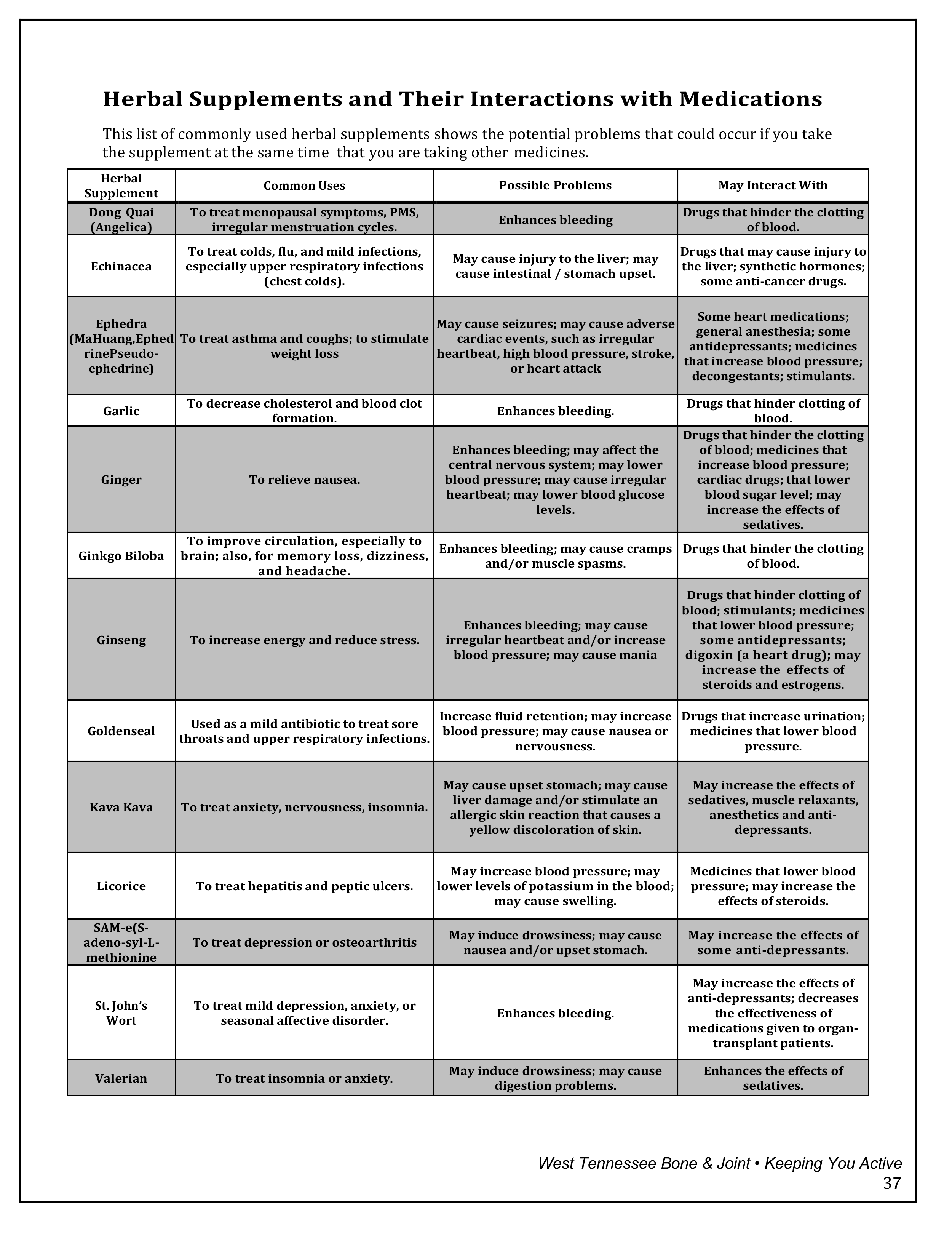
Download and print: checklist prior to surgery
Download and print: questions to ask
What are some of the risks involved in having a total shoulder replacement?
We want you to understand the benefits and risks of joint replacement surgery. The ultimate goal is for you to regain function of your shoulder with minimal pain and discomfort. Most people recover smoothly from surgery. Just like any surgery, there are risks involved in having a joint replaced. Some risks are more specific to total joint replacement, and others are risks of any surgery. Most patients have no complications from a total joint replacement.
Infection is a possibility with any surgery.
- Infection can occur at the incision site or internally, around the prosthesis. It is an uncommon risk, but it can be a potentially serious complication.
- You will be given antibiotics during and after your surgery to help prevent this complication from happening.
- If, however, infection around your prosthesis does occur, additional surgery may be needed to remove the infected prosthesis and replace it with a new one.
- After surgery, we ask for you to take prophylactic antibiotics for any dental procedure, surgery or other medical procedure that may increase your risk of infection in your blood stream that could travel to your prosthesis. Additional information about prophylactic antibiotics will be provided to you by your surgeon.
Other possible complications
Other possible complications include dental, nerve, heart or breathing problems.

